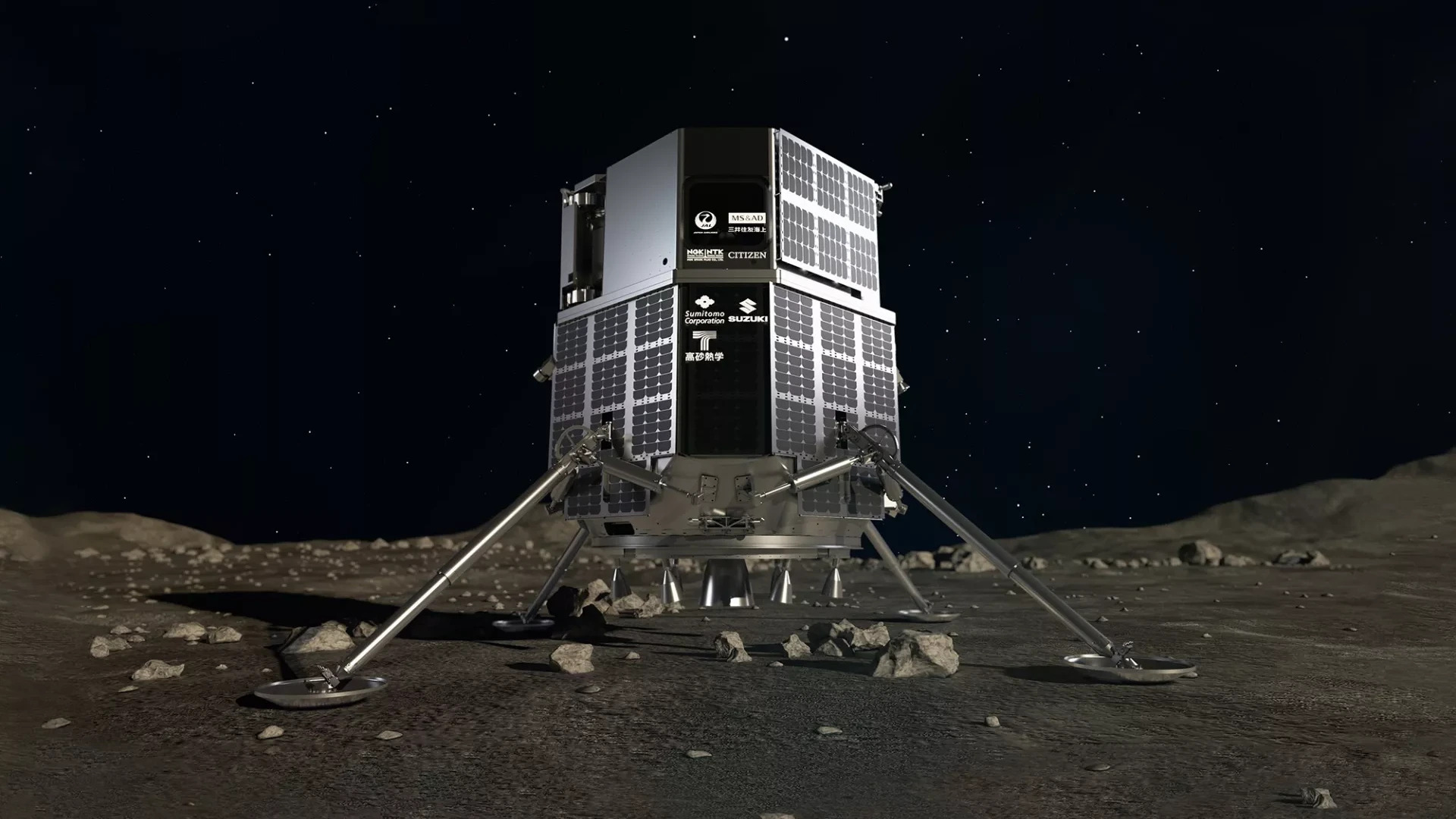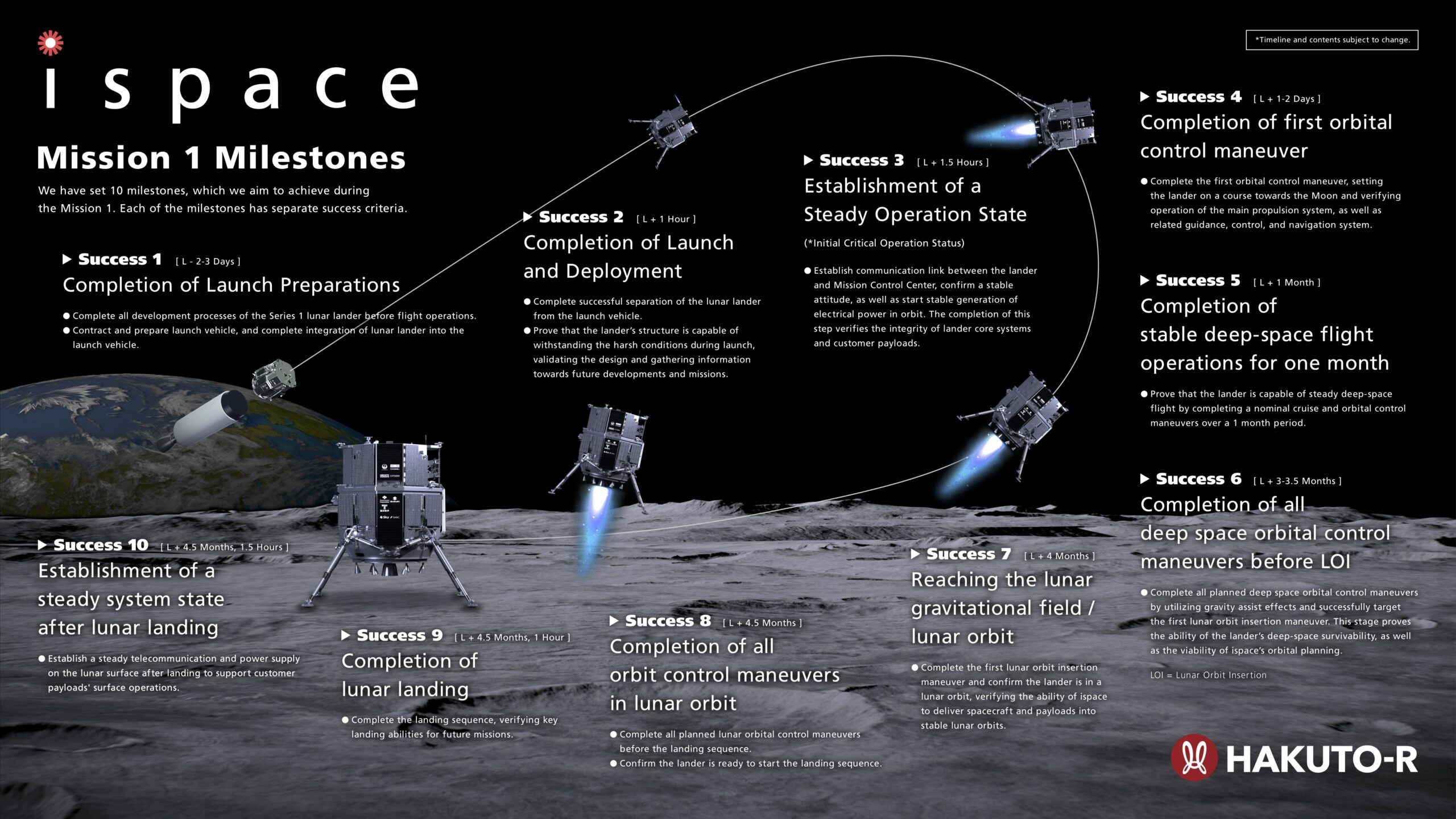SpaceX to launch Japanese moon lander, UAE rover on Nov. 30
Tokyo-based ispace aims to make lunar history.

A Japanese private moon lander is in a race to make history.
On Nov. 30, Tokyo-based ispace's Hakuto-R lander is scheduled to launch for the moon's Atlas Crater to ready for a soft touchdown, which may be the first ever by a private company on the lunar surface.
Hakuto-R will lift off atop a SpaceX Falcon 9 rocket from Florida's Cape Canaveral Space Force Station on Nov. 30 at 3:39 a.m. EST (0839 GMT) and arrive at the moon no earlier than April 2023. Following landing, Hakuto-R will deploy a small United Arab Emirates rover, called Rashid. The four-wheeled rover will study the moon for 14 Earth days using a high-resolution camera, a thermal imager, a microscopic imager and a probe designed to examine electrical charges on the lunar surface.
It's unclear if Hakuto-R will be the first private venture to touch down softly on the moon, however. NASA has tasked the company Intuitive Machines to launch its Nova-C lunar lander, scheduled now for March 2023, while Astrobotic's Peregrine lunar lander will lift off in the first quarter of 2023, according to Spaceflight Now's launch calendar. At this early stage, it's difficult to say which of these companies will land first.
"Our first mission will lay the groundwork for unleashing the moon's potential and transforming it into a robust and vibrant economic system," Takeshi Hakamada, founder and CEO of ispace, said in a statement Thursday (Nov. 17), one day after NASA kickstarted its Artemis human lunar program with the successful moonbound launch of the uncrewed Artemis 1.
Related: Artemis moon program will boost science and private spaceflight, NASA says
Landing safely on the moon is hard, especially for private companies, which don't have the resources of a national government. For example, SpaceIL's privately funded Beresheet lander crashed during its touchdown attempt. 2019. But a new era is coming nonetheless, featuring small commercial landers swarming on the moon to help pave the way for future human landings.
Get the Space.com Newsletter
Breaking space news, the latest updates on rocket launches, skywatching events and more!
NASA's Artemis program is supporting a fleet of companies like ispace, Astrobotic and Intuitive Machines under the Commercial Lunar Payload Services program (CLPS) that will bring even more robotic missions to the surface in the coming decade. (Hakuto-R isn't supported by CLPS, but ispace's partner Draper was tasked by NASA to lead a team performing a daring lunar far-side landing slated to happen no earlier than 2025.)
Related: Private moon landers may need more customers than just NASA
The primary landing site of Hakuto-R, Atlas Crater, is on the northeast quadrant of the moon near Mare Frigoris ("Sea of Cold"). The site was chosen to "maintain flexibility during operations," ispace said, but the company didn't release many specifics apart from saying the site allows for "multiple contingencies" during the long transit phase of the mission.
"Careful consideration of the target site criteria included continuous sun-illumination duration and communication visibility from the Earth," ispace officials wrote. "Alternative landing targets include Lacus Somniorum, Sinus Iridium and Oceanus Procellarum, among others."

"Hakuto," which means "white rabbit" in Japanese, was the name of the ispace-managed team for the Google Lunar X-Prize (GLXP). The GLXP offered $20 million to the first private group able to land on the moon and do a few tasks, but concluded in 2018 with no winner receiving the prize.
Hakuto-R (the "R" stands for "rebooted") was at first slated to land on the moon in 2021, but was held up due to technical issues and other matters. The company aims to eventually enable human settlement using lunar water ice that can be mined in situ.
Editor's note: This story was updated at 11:20 a.m. EST on Nov. 25 with the new target launch date of Nov. 30.
Elizabeth Howell is the co-author of "Why Am I Taller?" (ECW Press, 2022; with Canadian astronaut Dave Williams), a book about space medicine. Follow her on Twitter @howellspace. Follow us on Twitter @Spacedotcom or Facebook.
Join our Space Forums to keep talking space on the latest missions, night sky and more! And if you have a news tip, correction or comment, let us know at: community@space.com.

Elizabeth Howell (she/her), Ph.D., was a staff writer in the spaceflight channel between 2022 and 2024 specializing in Canadian space news. She was contributing writer for Space.com for 10 years from 2012 to 2024. Elizabeth's reporting includes multiple exclusives with the White House, leading world coverage about a lost-and-found space tomato on the International Space Station, witnessing five human spaceflight launches on two continents, flying parabolic, working inside a spacesuit, and participating in a simulated Mars mission. Her latest book, "Why Am I Taller?" (ECW Press, 2022) is co-written with astronaut Dave Williams.









